
Sankeyville - an early view

Sankeyville - an early view
The history of Canadian railroading has few more stirring chapters than that written by the Rusty Railway. Powered by the acquisitive mania of the dynasty established by its patriarch John Sankey, and carried on by his sons Michael and Arthur, the Rusty Railway was the cornerstone of a grand plan to corner the world toaster market.
The RR was initially formed by the amalgamation of the Rockslide & Cave-in Tramway and the Mud Marsh & Washout Railroad. Its construction took ten years. During this time, it experienced as many problems from civil servants, porcupines and a dead dog, not to mention tight space constraints, as were ever faced by a pike. [An erected pike is a seminal symbol of the transfer of unconscious libido to a cultural purpose by the Jung at heart.]
The R&C, which became the Rocky Ridge Sector of the RR, was built by the canny Bilk Billings to profit from a bureaucratic bungle in the railway subsidy program. [Billings was an early businessman in the Ottawa area, who successfully persuaded his neighbours to pay for a bridge across the Rideau River for his farm. His large clapboard house is still preserved as a museum to encourage modern-day civil servants to emulate him.] The federal railway construction subsidy at the time was $3200 per mile, $6400 for difficult terrain requiring tunnels and bridges. However, as first published in the Canada Gazette, the subsidy for tunnels was misprinted as $64,000 per mile. As a result, the R&C consisted entirely of a tunnel, for very small streetcars, under the Mica Mountains. The track ended abruptly at the Muskrat Marsh.
The MM&W, which became the Muskrat Marsh Sector of the RR, was built about the same time by the Valley lumber baron John McBooth who had just purchased the vast O'Shaw estate. The MM&W became so busy during the logging of the estate that McBooth reportedly considered making it Canada's first double-tracked line.
The O'Shaw estate abutted Muskrat Marsh. The estate clear cut, McBooth initiated action under the Ontario Drainage Act to require Billings to pay for the drainage of the marsh, so it would be cheaper for him to extend the MM&W to the trees on the other side. Billings countered by filing a proposal with the Export Development Agency to ship the water of Muskrat Marsh to the United States. This resulted in a bidding war for the MM&W between Jack DeMiner, a conservationist who wanted to preserve the marsh and the Itty-Bitty Bitterns that bred there, and the Committee for an Independent Arnprior, who feared that the Americans would use the sale as a precedent to use the Mississippi River to drain the Arctic Ocean. The value of stock in the MM&W soared. [The birds are referred to as Bitterns Canada in federal documents. The American Ornerythologists' Union first decreed their name to be Northern Bittern, then Tundra Bittern, then Lesser Bittern. Since the establishment of free trade, it recognizes them only as a race of American Bittern.]

an Itty-Bitty Bittern
Sankey, however, had been assured by a French seer, Monsieur Jean Nixon, that the toasters of the future would be made with mica. The Mica Mountains contained a vast quantity of mica, of a quality unrivalled in the world. So, Sankey hired a publicist, Marley Fowat, to convince Americans that the Arctic Ocean was salty and thus of no use to them. [Once introduced to the area, Fowat wrote many popular books on Canada's north. However the American CIA did not appreciate his report on the Arctic Ocean - he was later banned from the country as a subversive.] And, he paid a visit to Billings to suggest that a complaint with the Canadian Human Rights Commission might be imminent, for the R&C had no women as directors. Billings realised that the game was up - the CHRC would quickly discover that a brother of the Queen's Printer [the publisher of the Canada Gazette] was a director of his railway.
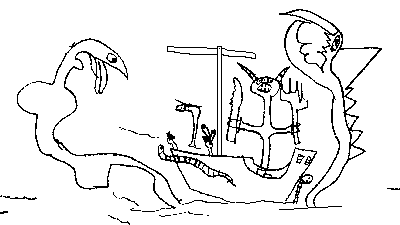
the legendary Muskrat Marsh Monster
Finally, at a marathon non-stop negotiating session [a technique copied a century later at a place called Meach Lake], Sankey achieved agreement of all parties to a deal that became known as the Muskrat Marsh Accord. As he put it at the time, "everyone wins with this agreement". McBooth was granted lumbering rights along all rights-of-way of the RR, Fowat received free transportation of his books on the RR, Muskrat Marsh was donated to the DeMiner Nature Federation in return for a charitable deduction, the directors of the R&C were allowed safe passage to Cuba with the subsidy money [a solution repeated by the Canadian government some years later to resolve an impasse with some terrorists], and the Queen's Printer agreed to take early retirement. Sankey ended up owning both railways.
The civil service, obviously, did not feel that they had won anything. Soon, the government passed an omnibus Conflict of Interest Act, an obscure clause of which prevented a person who owned a town from serving as its mayor. It obviously was aimed at Sankey, who owned Sankeyville.
It is sometimes overlooked that Sankey is a descendant of Attila the Hun, who finished off the Roman Empire. In a now classic series of manoeuvers, he set up a holding company, I Own U Inc. This company transferred the mica claims of the R&C to Mike's Mica Corp., set up Alan Aviation Ltd. to buy and operate the Sankeyville airfield, and gave the Sankeyville Tavern to Sankey's daughter in an in-vivos trust. [The only income-producing property in Sankeyville, it was renamed Chez Evelyn, and the bar became known as Whisky's, the apostrophe-s giving some credence to the otherwise undocumented belief that it was named after a pet cat.] He persuaded the commanding officer of the local regiment to privatize the town militia, then obtained the contract for his youngest son, Arthur. [The Arthur's Armoury Inc. CGHQ building is now a war museum, complete with a mammoth outside the front door to evoke the efforts made by the first soldiers of the area to obtain fur to keep warm. Resentful civil servants later put a whole family of mammoths outside one of their museums in Ottawa to compete.]
Next, he established Sandy Sewage Lagoons Inc. to take over the night soil business in Sankeyville. [A rumour was current at the time that Sandy was his pet cat. No evidence for this has been documented - in fact if all the rumours concerning Sankey pets are to be given credence, his house must have been a zoo.] Tom Bomb Disposal Associates was incorporated to handle "toxic wastes from the airport property", in anticipation, Sankey insists in his memoirs, of the Environmental Protection Acts of today. [X.Humer has noted that a Tom Bombadil was a well known singer of the period. Sankey, however, appears to have not been a fan of modern music.]
Alan Aviation then leased an unneeded runway to a numbered company [1 Ontario Ltd., later to become Consolidated Toasters Incorporated] and converted part of its holdings to a park [known as the Mouse Meadow Conservation Area, it is distinctively decorated with signs prohibiting cats], while Mike's Mica did the same with part of the Mica Mountains that had no mica. The tax credits thus generated were used in a reverse takeover of the whole town by IOU. Since IOU now legally owned itself [the only prior successful instance of this manoeuver seems to be Britain's London Bridge, which achieved this status a century earlier], Sankey could once again run Sankeyville as he wished.
He then hired a cantankerous white-whiskered surveyor, A.B.Codger [who had located a railway for the CPR a few years earlier], to find a railway route to the mica deposits that would not require so much as a square inch of crown land. Legend has it that Sankey promised to name a portion of the Rocky Ridge after him, but that the old man retorted, "Rats. I've already got my name on the map. That's what you can call your gulch, 'Rats'". Apocryphal story or not, the location of the best mica deposits was named Ratsy Gulch, and the line to it did not require a crown land lease. [Yet another pet rumour current at the time, also unsubstantiated, was that the site was named after a white rat of Sankey's daughter.] In an act of generosity to McBooth unusual for the time [so generous that some investigators even today still search for an "unwritten clause" of the Accord], the connection to Sankeyville was run through the best stand of pines in the region. This portion of the railway became known locally as the Pine Line.
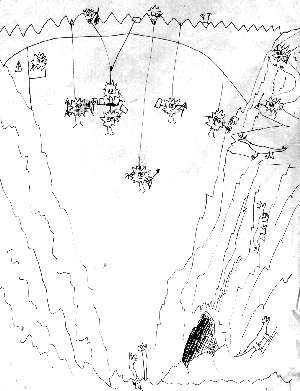
exploring Ratsy Gulch
By now always on the lookout for a way to do in the civil service, Sankey discovered a tax loophole which allowed the writeoff of a kilometer of track for each turnout on a line, and promptly ordered the line to be constructed henceforth entirely of turnouts. Unfortunately for Sankey, a disgruntled worker on the railroad hiked out to civilization and sent a telegram concerning the plans to the Minister of Finance. [Legend has it that the worker's dog had been crushed when a pile of ties, under which the dog was sleeping, collapsed. Locals still call a nearby track Dead Dog Siding.] Parliament was recalled to an emergency session, and the income tax act amended posthaste.
This episode had a curious sequel. For years, porcupines by the dozens congregated around the group of turnouts hurriedly built during this period. Many were the tales of railwaymen who found that a quill had pierced a boot, or had got into a sandwich. Finally it was discovered that the ties used for these turnouts were full of salt. How the salt got there is one of the little mysteries of the Rusty Railroad. Be that as it may, the area is now known as Porcupine Junction. [The British philologist H.W.Fowl considers "porcupine" in this context to be a corruption of porcine, referring to pork-barrel politics. Fowl admits, however, that he has never seen a porcupine at work.]
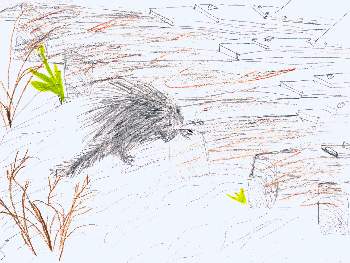
a porcupine at work
The last step required to connect mine and factory was the linking of the R&C and MM&W. A simple dike across the Muskrat Marsh was all that was needed. DeMiner asked only that the dike pass close to the most favoured spot of the bitterns and that a public footpath and birder observation posts be included, to be maintained by the railway "as long as the rivers run". [Sankey states in his memoirs that he foresaw the fate of the once-mighty Colorado River, all the water of which is now removed before it reaches its mouth, and therefore did not consider this commitment overly onerous.] Both, however, reckoned without the enmity of the civil service, which by now was at fever pitch. A clause was quietly added to the next piece of legislation on the parliamentary order paper [an amendment to the Indian Act respecting the licensing of drinking establishments on reserves, as part of the definition of the term 'watering hole'] declaring Muskrat Marsh to be a navigable waterway. It received royal assent before anyone noticed.
The uproar that followed has few parallels in Canadian history. Every environmentalist in the country rose as one to denounce the imminent desecration of the marsh by water skiers [a bit prematurely, as it turned out - outboard motors were not mass produced until 50 years later]. A special railway car was despatched from Vancouver to Ottawa to collect signatures on a petition. [The car contained a sufficient quantity of wheat that it qualified for the Crow's Nest Pass rate.] A newspaper boy from Moncton began to skateboard from sea to sea in protest. [However, no record has been found of his journey beyond the city limits, where the roads ended.] Meanwhile the women and children of Sankeyville loudly bewailed to their MP the prosperity and jobs that would be lost to them if they were not connected to Bay Street.
The manner in which this impasse was resolved made Sankey's name a legend. [Some, with present-day sensibilities in mind, have even proposed that Sankey replace his ancestor Lady Godiva as the patron saint of engineers.] Many years before, the world's first successful railway suspension bridge had been completed across the Niagara Gorge, a navigable river at that point. It's rail bed was 2.7m wide, adequate for the trains of the day. But, the Pullman Company had to make their bedroom-equipped cars wider than this if they were to meet CPR specifications [due to the bulk of the general manager of the line. Successful men were expected then to have an ample girth]. And, the Union of Serious Scientific Researchers had designated the bridge a World Technological Marvel, so the Whirlpool Bridge Company couldn't tear it down.
Under documents newly obtained under the Freedom Of Obfuscation Act, it has now been established that Pullman offered Sankey a substantial commission if he could arrange a deal. A series of ads soon appeared, showing passengers stepping out of luxurious Pullman cars, then being stuck into barrels to negotiate the Whirlpool rapids. And, the tune of "London Bridge is Falling Down" began to be heard on every street in the country. It is believed that the bridge company, its business plummeting, offered Sankey an even larger amount to be their "advertising agent". Then Sankey announced that the old bridge would be moved to soar over Muskrat Marsh. And, the civil servants discovered to their horror that the Navigable Waters Act contained no prohibition against moving a bridge from one navigable watercourse to another.
With advice from the son of the original builder of the bridge [Washington Roebling, who completed the Brooklyn Bridge after his father was killed by a ferryboat whose business would be taken away by that bridge], the girders were unrivetted into sections the length of a railway car. Meanwhile, McBooth constructed a stack of lumber rafts on the roof of a powerhouse just below the falls. Late the next winter, some of McBooth's log drivers, experts in log jams, created a jam of ice at the Lake Erie entrance to the Niagara River. For the only period recorded in history, Niagara Falls was still. [Some still attribute the ice dam to natural forces.] In the now calm river, the rafts were floated into position, the bridge, sections dangling from the cables like charms on a bracelet, was lowered onto the rafts, then the assemblage quickly floated below the Whirlpool rapids before the ice jam gave way.

towing the bridge across Lake Ontario
The rafts were towed to Kingston. There, all the flatcars of the little Kingston & Pembroke Railway [locally known as the Kick & Push, it was only completed to Renfrew, but was, nonetheless, purchased by the CPR shortly after this incident] were backed into the lake on a specially-built spur, and the rafts floated over the cars. With every engine the K&P owned billowing smoke, the rafts, and bridge, were pulled out of the lake and moved to Muskrat Marsh. One weekend, a temporary trestle was quickly put up across the marsh. The train moved into position, the bridge reassembled, and the trestle removed, all before a bailiff could hike in to deliver an injunction. [Nine years later, the charge of violating the Navigable Waters Act was dismissed on the grounds that no vessel had in fact been impeded.] The deck was repainted a normal black, but the cables were covered in gleaming gold. [Black and gold were the colours of the favourite scotch of Sankeyville. It was made by a local distiller, Sam Bronson, after whom an Ottawa road is named. Bronson changed his name to a more fashionable Jewish equivalent once business opened up due to prohibition in the United States.] Then, Ottawa found that, under the Navigable Waters Act, the government had committed to pay one-half the cost of the first bridge over any navigable waterway, gold leaf and all. Let us, oh gentle reader, draw a discrete veil over the subsequent comments of the Auditor General.
Now, with money to burn, a toaster empire could be forged. There were three things wrong with toasters of the time, according to Sankey: they burned the toast unless someone sat over them, they only toasted one side at a time, and they were made by someone else.
Sankey decided to look after the technical problems first. So, he proposed to the Nutty Research Council that they build a generic foundation for the understanding of toast technology. [Originally formed to develop a full sweet hickory nut that would compete with imported pecans, this organization survived, by traditional civil service techniques, to run most of Canada's national research laboratories.]
In the first interim NRC report, there is an abstruse but tantalizing hint of a union of space and time [a theme later exploited by a German, Albert Einstein]. However, mindful that their research must be relevant to industry, their primary effort was focussed upon a prototype electrified grandfather clock. This, it was felt, with further development, would be suitable for shutting the damper of a kitchen stove after a set time interval. [The clock is still on display at the Institute for National Measurement Standards of the NRC. The device was later commercialised by an American, Tom Watson, to time-stamp detective stories at libraries.] Further work was proposed to measure time more accurately, as well as to determine the length of time required to toast various types of bread.
Their next report mentioned briefly some curious aspects of heat radiation [later publicised by another German, Max Planck] which, they felt, might be worth studying. However, under a new policy of contracting out research to the private sector, most of the funds that year went to a consultant. Her thousand-page report discussed friction in the bearings of vane bolometers which might be used to measure the temperature of pieces of toast. [A pencilled note in the NRC library copy indicates that she then got a defence contract to reduce friction in cannon wheels.]
The final NRC report, potentially a quantum leap in the understanding of matter, proposed that the discharge of electrometers near burning toast had something fundamental to say about the structure of matter. But, following a budget cutback, the chief scientist on the project [E.A.Millikelvin, who was later to found particle physics with his book "The Electron"] left for the United States, leaving behind only a design of a flame detector which, it was felt, might be used to shut the damper of a stove at the first hint of toast-burning. [This was an innovation so ahead of its time that it has still not been integrated into toaster technology. The mechanism is not used to turn off the toaster, but just to turn on a fire alarm.]
Pondering this material one day over his usual bottle of Best Old rye, Sankey was joined at Whisky's Bar by a visitor. Thomas Edsel, a draft dodger from the United States, looked at the heap of reports. Then, he connected a spring between the handle of a toaster rack and one side of the bar stove, tied the rack to the other side of the stove with solder wire, and put a piece of toast on it. When the toast was done, the solder wire melted and the spring threw the piece of toast across the room. And so the pop-up toaster was born.
Of course, the mechanism had to be made safe [in his memoirs, Sankey claims that the piece of toast bounced off his head], and reset itself automatically. Hundreds of trials ensued. When the heap of rejected toasters began to block the basement window, work continued in the attic [despite protests of the Fire Commissioner that the fire exit regulations for a single-family home with more than twenty-five stoves were thereby violated]. One day, Edsel realised that one of the toaster racks was bent out of shape. Due to poor manufacture, it warped when heated. The long search was over, and a small piece of metal, warped by the heat of the toaster element until it releases a spring catch, has timed toast ever since. [Believing in the manifest destiny of an infinitely improvable future for mankind, Edsel was so dismayed by Canadian politics that he then returned to the US to become a telegraph operator.]
Now Sankey had to persuade people that they needed his new toasters. Advertisements of the day were essentially of two kinds: business cards of self-respecting firms, and testimonials for patent medicines [so called because they patently were not medicines]. Sankey visited 'The General' McLulu of Toronto University [he later decided that 'Marshal' better suited his self esteem], who was reputed to have a way with words on such things. "Effective advertisements will be a subliminal pill for the subconscious", said McLulu. "They will exercise a hypnotic spell, particularly upon sociologists. They will dramatize communal experience." Sankey, one of the few to understand McLulu's pronouncements, realised that McLulu was actually admitting that he didn't know why people made toast. [In later years, when introduced to an audience as "one of only two people in the world who understand McLulu's writings", Sankey is reputed to have asked, "Who is the other one?"] Combing the libraries, Sankey found only that Sheer Height [an Iroquois whose spicy legends were later quoted extensively in histories of the Hudson's Bay Company] considered toast to be an iconic archetype of the grass fires used by early North Americans to stampede mammoths over cliffs.
But, McLulu had said something else: "Newspapers are not the communicators of news, but the creators of news". And so it was that the Gidday Poll began. [It later went national, and was renamed the Gallop Poll in honour of Canada's native son, Pa Cartwright.] People chosen at random were given a demonstration of a pop-up toaster, then asked if they preferred it to what they had. A series of ads then appeared, concealed, as was the custom then, as news items, letters to the editor, etc., each describing one of these demonstrations. It seemed that everyone could identify with at least one of them. The toaster magnates of the day, Sergeant 'Electric' Jones [given his nickname for his galvanizing lectures to troops, he was later promoted to general] and Dr. Eastinghouse [his company was renamed after it was taken over by the Alberta Heritage Fund], were at first elated. Everyone in the country had decided that a toaster was what they wanted for their birthday. Until the results of the poll were announced: 99 44/100% of the people profiled preferred a pop-up toaster. [This strange percentage had such a hypnotic effect upon readers that the rights to it were immediately bought by a producer of soap, who used it successfully for many years.]
Desperate for money to retool their factories to make the new style toasters, one by one the toaster company board chairmen approached the luncheon table of financier Bonrad Clack at Chez Winston [the French prefix was dropped when Laurier became Canada's first francophone prime minister]. First, Clack announced that he would not throw good money after bad. Then, when their stock collapsed, he bought them all up. They soon suspended business due to labour problems, and Clack used their pension funds to buy some newspapers.
By now, Sankey was convinced that people made toast simply because other people did. And so it was that the now-famous series of lifestyle photos began appearing under the title "The Toast of the Nation". A franchise for budding politicians, Toastmasters International, was established to instruct students in the toast ceremony. [It is believed by some analysts that MacDonald's was established after its founder read Sankey's description of the technique in "The Japanese Yen for Money".] Canadian Toast Company opera productions featured the aria "Toast! Aroma! Flavour!", which was displayed on every parlour piano. [Later parodied by a coffee company, the song was written by an out-of-work musician in return for a free meal at Chez Evelyn.] Soon, every new kitchen stove in the country was fitted with a Sankey Toaster, for none could be sold without one.
But, behind the craggy visage now familiar to every newspaper reader as the King of Toasters, Sankey was still unsure of himself. The unshakable prediction of Jean Nixon that the key to his empire would be found in the Mica Mountains continued to perplex him.
Then, one day, he received a brown paper envelope, containing a book by a British scientist, Michael Faraway. The accompanying note, from his old bar-room crony Edsel, said that it was the most important book of his life, that his future as the energy magnate of the world was now assured. Would Sankey join him? With funds of course? Sankey, perhaps remembering the piece of toast that had bounced off his head in Whiskey's Bar, did not pay much attention to Edsel's plea for money. But, when he read Faraway's report that electric loops sometimes got too hot to touch, he made the creative leap that has ensured his fame to this day. The meaning of Nixon's cryptic prediction was now clear. Mica could be used to hold wires that would become even hotter than Faraway's coils. Electricity could replace seasoned hickory wood in the making of fine toast.
The rest is history. No more need anyone spend hours splitting wood and keeping the home fire burning simply that he might have a decent slice of toast. Generations have now arisen who have never experienced a world without the electric pop-up toaster, indeed can not conceive of a world without one.
May it always be so.
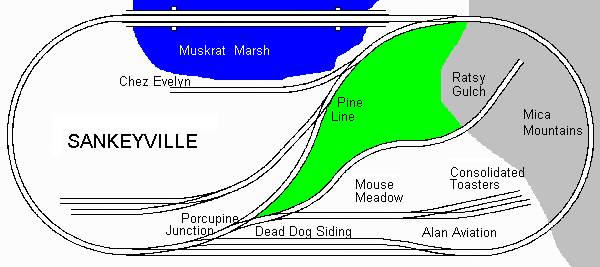
the Rusty Railway - 0.8 x 2 m HO
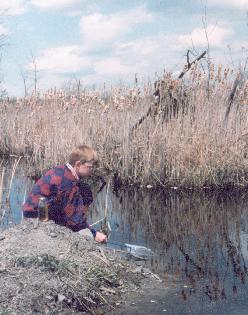
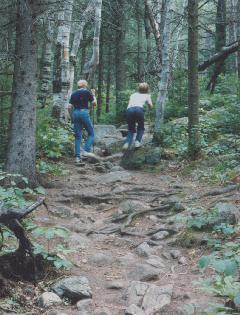
Muskrat Marsh the Rocky Ridge

Mouse Meadow